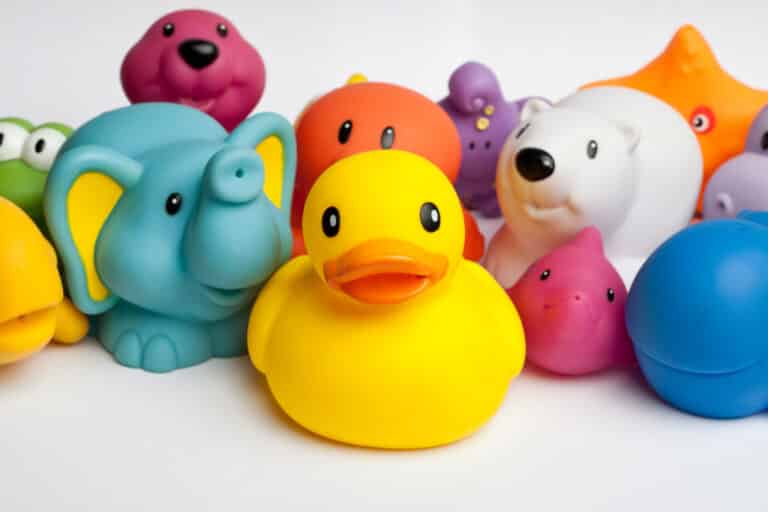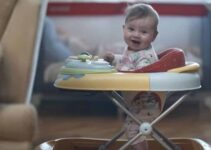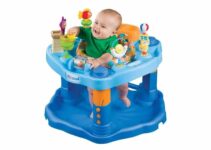It isn’t always clear which toys can be cleaned and how to clean baby toys the right way. Let’s discuss all the different aspects of cleaning baby toys so you know exactly what to do.
But first, let’s understand why you should take the time to do this. It is very important to clean and disinfect your baby’s toys regularly. Like anything that is touched often, their toys can collect germs that can be harmful to their health. This is especially true since babies are known to put anything and everything within arm’s reach into their mouths. Since the toys will undoubtedly go into your baby’s mouth, so will those nasty germs living on their surface.
It’s also important to understand the difference between cleaning and disinfecting. Cleaning involves removing dirt, grime, and reducing germs. Disinfecting involves killing germs using chemicals.
Table of Contents
- How to Clean and Disinfect Baby Toys
- How to Clean and Disinfect Bath Toys (Including Foam and Rubber Toys)
- How to Clean and Disinfect Squishy Silicone Toys
- How to Clean and Disinfect Hard Plastic Toys
- How to Clean Cloth Toys and Dolls
- How to Clean Plush Baby Toys & Stuffed Toys
- How to Clean Wooden Baby Toys
- How to Clean Electronic Baby Toys & Toys With Batteries
- How to Clean Baby Books
- Cleaning Methods Explained
- Disinfecting Methods Explained
- Frequently Asked Questions
How to Clean and Disinfect Baby Toys
Let’s break all sorts of different toys into categories since the cleaning and sanitizing process won’t look the same for every material. I’ll start by explaining how to clean and disinfect each type of toy, and then I’ll explain the exact steps required for each method.
How to Clean and Disinfect Bath Toys (Including Foam and Rubber Toys)
Toys like rubber ducks have little openings where moisture can get in. Cleaning them often will prevent mold from growing inside these toys.
You can clean bath toys in the dishwasher if the label says it’s ok to do so. To disinfect, use diluted bleach or white vinegar.
These methods work well for any type of foam or rubber toy that your baby plays with!
How to Clean and Disinfect Squishy Silicone Toys
To clean, use vinegar or boiling water. Then disinfect with a diluted bleach solution. The solution should be wiped on the surface and left to air dry. After that, the toys should be rinsed with warm water thoroughly to remove any chemical residue, and let them air dry again.
How to Clean and Disinfect Hard Plastic Toys
Plastic toys like teethers, rattles, and building blocks are very easy to clean when needed.
Warm soapy water is an easy and very effective way to clean plastic toys, especially since they can’t stand up to the heat of boiling water. Use a brush to clean the crevices of dirts or residue. After washing, they can be disinfected with diluted bleach or another chemical disinfectant.
If you check the toy’s label, it might be dishwasher safe.
How to Clean Cloth Toys and Dolls
Many fabric toys are not machine washable, and they often give you cleaning instructions on their tag.
Usually a simple scrub down with mild dish soap will be enough.
Since air drying can take some time, you can opt to use a hairdryer to speed up the process.
Dolls are the same way. You can spot clean them with plain water and mild soap.
How to Clean Plush Baby Toys & Stuffed Toys
It may seem more difficult to clean the fluffy toys, but don’t worry. If the label says it’s ok to do so, put them in the washing machine.
If you can’t place them in the washing machine, you can wash plush toys in the same way as the cloth toys by using warm water and dish soap.
After washing the toys, you can use a garment steamer to sanitize.
How to Clean Wooden Baby Toys
These baby toys are simpler to clean than you may think. You can either use a water and vinegar cleaning solution or mild soap. These are the most natural cleaners and will keep the wood toys in good shape as well as germ-free.
How to Clean Electronic Baby Toys & Toys With Batteries
If you’re wondering if it’s safe to clean any sort of electronic toys or toys with batteries, it is—as long as you do it the right way. The first thing to remember is to remove the batteries before cleaning and replace them once they’re dry. These toys won’t benefit from any sort of hand washing, so using a disinfectant wipe is the best option.
First wash off grime with a cloth moistened with detergent and water and wrung out. Then the toy should be air-dried before disinfecting with alcohol or a disinfectant wipe. The surface should remain wet for the time specified on the label (called the contact time) and then air dried.
How to Clean Baby Books
There are two ways to safely clean your baby’s books.
If the books need quick cleaning, sometimes a baby wipe will do the trick. This is especially true if there is visible dirt on them. Then you can disinfect with an alcohol or other disinfectant wipe.
Another option is to spray diluted chlorine bleach.
Cleaning Methods Explained
How to clean baby toys in the dishwasher
Certain silicone and foam toys can be placed in the top rack of the dishwasher for quick cleaning. Check the label or do a little research just to be safe because some materials don’t hold up well with hot water cycles or repeated washings.
You will want to run a regular hot water cycle, and that should be enough to get them clean and kill germs.
How to clean baby toys in the washing machine
Most stuffed animals can be put into the washing machine with mild detergent and washed on a gentle cycle with warm water. Always check the label before doing so. Many parents recommend placing the stuffed animals into a mesh bag for protection during machine washing. A pillowcase knotted at the top can also be used.
Disinfecting Methods Explained
How to disinfect baby toys with bleach
There are two effective ways to use chlorine bleach to clean your baby’s toys
Using 1/2 cup bleach per gallon of water works well for cleaning certain books and toys. Diluting the bleach makes it much safer to use.
It is best to put the solution into a clean spray bottle and lightly spray and wipe. Best practice is to spray into a towel to keep chemical fume dispersion to a minimum. Do not spray chemicals when your child is nearby. Then use the towel to disinfect books, toys, and other surfaces.
Another option is to place the toys in the bathtub or sink with the diluted bleach solution for around 10-15 minutes, rinse thoroughly, and then air dry.
Make sure there is good ventilation whenever using chemicals.
How to disinfect baby toys naturally with white vinegar
Many parents like to stay away from anything that can contain harsh chemicals when it comes to things that their little ones come into contact with. This makes good sense when the items frequently find themselves in baby’s mouth! If this sounds like you, the most natural way to clean toys is with white vinegar.
You can use vinegar the same way you use bleach. For every 1/2 cup of vinegar, add 1 gallon of water. Fill the bathtub with the solution, and soak the toys for about 10 minutes. Always be sure to properly rinse afterward and allow toys to air dry.
This solution can also be used on household surfaces.
How to disinfect baby toys in boiling water
Place the toys in boiling water for about 3 minutes. The hot water is great for killing germs.
How to disinfect toys with a garment steamer
When used with high heat, the steam will kill most bacteria and viruses (including the coronavirus) and eliminate any pesky dust mites. Most of these will die at 212 degrees F.
Below are the most common questions and answers on this topic:
Frequently Asked Questions
How often should you clean baby toys?
Cleaning and disinfecting your baby’s toys should be done regularly. This includes stuffed animals and even wooden toys as well. Teethers or other toys that frequently go into your baby’s mouth should be cleaned daily or every other day since they can be a breeding ground for germs. Other toys like bath toys can be cleaned weekly. The real answer will come down to how often they are played with, how they are played with, and if they are shared. Sometimes a simple wipe down is enough, rather than thoroughly washing toys every single day. Usually, you can tell when certain toys need cleaning if they have visible dirt on them. If your baby has been sick, they should be cleaned and then disinfected. Additionally, if they are shared with siblings or other children, daily is best.
Cleaning, sanitizing, and disinfection frequency table. (The National Association for the Education of Young Children has a handy pdf with cleaning, sanitizing, and disinfection frequency, so you might want to download it and keep it in a visible place in your home.
How do you disinfect toys that can’t be washed?
You can wipe the toys down with a damp cloth and a little bit of mild soap or use disinfectant wipes. Some parents even use disinfectant aerosol spray and then let them dry.
How do you disinfect a large number of toys?
If the toys you are looking to clean can be submerged in water, the bathtub is your best friend. Adding the cleaning solution in the tub with the toys and soaking them is easiest this way. If they are dishwasher safe or can be cleaned in the washing machine, those methods are quick and easy, too.
Is Lysol safe for babies?
Yes. Before your little one gets the toys back, they should be completely dry. You can rinse them or wipe them down with a wet cloth after using the Lysol if you choose to, but it’s not necessary.
Are Clorox wipes safe for babies?
Yes. You should treat the Clorox wipes the same as you do Lysol. Make sure the clean toys are dry before giving them back to your baby.
What about old and second-hand toys?
Since other children have played with them, and you don’t know when they were cleaned, there is a good chance used toys can harbor germs. Follow the instructions based on the material they are made out of, and give them a thorough cleaning and sanitizing before giving them to your baby.
For more information:
CDC website: https://www.cdc.gov/coronavirus/2019-ncov/prevent-getting-sick/disinfecting-your-home.html




